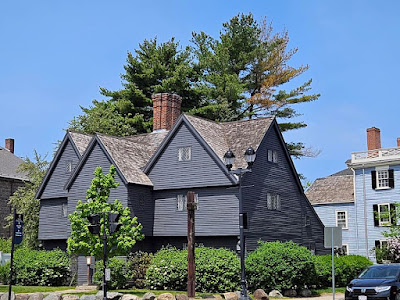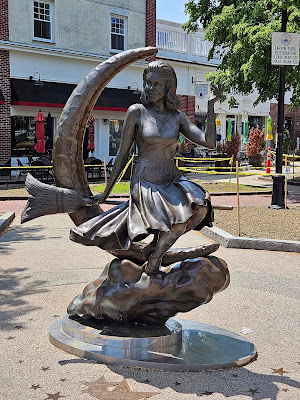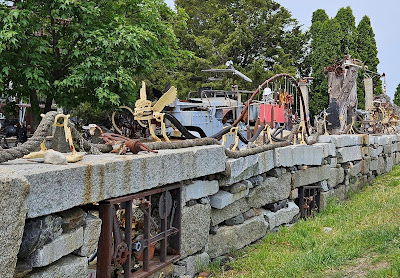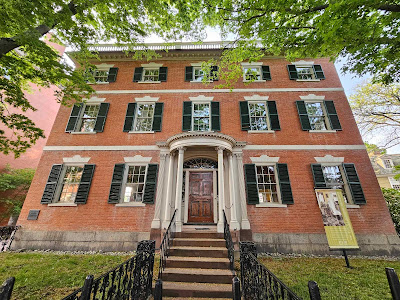Two days after running the Maple Leaf Marathon in Vermont, I ran the Pine Tree Marathon in Portland, ME. This post picks up where the last one left off.
Saturday, May 13
After spending an extra
night in Vermont, Deb and I drove to Portland.
As soon as we got to Maine, we stopped at a visitor information center,
where one of the guides gave us directions to a nearby lighthouse. Our next stop was the Nubble Lighthouse at
Cape Neddick.

There are numerous other lighthouses
along the Maine coast, but we didn’t have time to see them all. Instead, we continued to our hotel in Portland.
When we arrived, they
didn’t have a room ready. While we
waited, we went to see five lighthouses in Cape Elizabeth and Portland. The first was this lighthouse at Dyer Cove,
near Two Lights State Park. There are
actually two lighthouses here, but only this one is visible from the road.

Next we went to Fort
Williams State Park, where we saw the Portland Head Light. The museum isn’t open this early in the
season, but we were able to view the lighthouse from two different angles.

From there, we could also
see the Ram Island Ledge Light.

Next, we drove to Fort
Preble, where we could get a view of the Spring Point Ledge Lighthouse.

Our last stop before
returning to the hotel was Bug Light Park.
From the park, we got a nice view of the Portland Breakwater Lighthouse,
which is affectionately known as the Bug Light.

By now, our room was ready,
so we checked in, unpacked, and got settled into our room. Then we went for dinner at Moe’s Original
BBQ. I don’t typically have BBQ for a
pre-race dinner, but Deb was in a mood for pulled pork.
I didn’t get to sleep as early
as I wanted to, but I managed to get about six hours of sleep. I was hoping for more, but that was enough to
get by.
Sunday, May 14
Sunday was race day. My race number was the same one I used for
the Maple Leaf Marathon, since both races were part of the same series. That meant I didn’t have to get there early for
packet pickup. We also didn’t have to
allow as much time to drive to the race venue, since our hotel was much closer
this time. That gave us the luxury of setting
our alarms 15 minutes later than we did on Friday. The race started at 6:00 AM, so we weren’t
exactly sleeping in.
We had to leave before the
hotel breakfast started, but we had leftovers from our dinner on Saturday.
The overnight low was in the
mid-40s, and it was supposed to get into the low 50s by the time I
finished. That was deceptive,
however. When I ran this race last year,
there was a cold breeze blowing in from the coast. When I took another look at the forecast, I
saw that the “feels like” temperature was in the upper 30s. With that in mind, I wore my cheetah outfit,
with a long-sleeved polypro shirt underneath.
Those were the warmest clothes I brought.
The course was a loop around
Portland’s Back Cove. We started and finished
at Back Cove Park. Deb and I arrived at
Back Cove Park just as the sun was rising.
When I got out of the car, I was surprised how cold the wind was.

The race started with a short
out-and-back. Then we had to do seven
laps around the cove. I’ve run this race
twice before, so I was already familiar with the course. It’s mostly flat. The only hill is the climb up to a bridge.
I ran a marathon on Friday, so
I knew I wasn’t going to be fast in this race.
My plan was to run at a pace that felt comfortable and not worry too
much about my time.
As we started the out-and-back,
we were running into a stiff headwind. I
didn’t think I was running fast, but it felt tiring almost immediately. I slowed down a little.
Coming back from the
turnaround, the wind was at our back, so it felt easier. I ran the first mile in 9:32. I knew that was too fast, so I slowed
down. After that, my next several miles
were all slower than 10 minutes.
There was a single well-stocked
aid station in the start/finish area.
While I was running, Deb was volunteering at the aid station. When I finished the out-and-back, I was still
cold from running into the wind, and I didn’t feel thirsty. I still took the opportunity to drink some
Gatorade, knowing it would be 3.6 miles before I got another chance.
The trail we were running on
was mostly gravel, but it was firm. I
don’t think it was appreciably slower than running on pavement. There weren’t any roots or rocks that you
could trip on. It was a good running
surface.
In my first full lap around the
cove, my pace was between 10:00 and 10:15 per mile. I wasn’t trying to hold any particular
pace. I ran at a pace that felt
relaxed. I paid more attention to my
effort than my pace. I knew I was
starting the day with tired legs, so I paced myself conservatively. I didn’t want to be suffering in the second
half.
In my second lap, my pace
continued to slow. I felt like my effort
was about the same, but my pace was now closer to 10:20 per mile.
I was only seven miles into the
race when the leader lapped me. By the
end of that lap, four more fast runners would speed by me. I would see some of them again before the
race was over.
I experienced the wind in different
ways as I ran around the cove. It was
coldest near the start/finish area, where it was blowing in from across the
cove. On the west side of the cove, we had
a headwind. It was tiring running around
that side, but it wasn’t as cold, because the wind wasn’t blowing over the
water. I felt the wind least on the
north side. There, we were partially sheltered
by all the trees alongside the adjacent parkway
The most wind-exposed area was on
the east side of the cove, where we ran across the bridge. There, we had a tailwind. Everywhere else, I felt cold, but crossing
the bridge, I always felt sweaty. When I
eventually returned to Back Cove Park, I would feel the cold wind off the cove
while my clothes were still somewhat sweaty.
That made me even colder. I
repeated this pattern with each lap. I
was hot at times and cold at times, but overall, I think I was dressed about
right.
In my third lap, my pace slowed
to about 10:40. I felt like my effort
was still the same, but my pace kept degrading.
My slowest mile of the race was
mile 13. That was early in my fourth
lap, as I was running into the wind. At
halfway, I was on pace for a time in low 4:30s.
I expected to continue getting slower, but my pace stabilized after
that.
I was just past the halfway
mark when the leader lapped me for the second time. He wouldn’t be the only one to do that. There were other runners who I lapped multiple
times. The runners varied in ability by
a wide margin.
For the first half of the race,
my pace was trending slower. In the
second half, I started to reverse that trend.
I wasn’t consciously trying to speed up, but I may have subconsciously
picked up my effort a little as the remaining distance felt more manageable.
As I neared the end of my
fourth lap, my shoulders started to feel heavy.
Apparently, I didn’t just start the day with tired legs. I also had tired arms.
I always felt warm crossing the
bridge, but my fifth lap was the first one where I started getting hot before
the bridge. In that lap, I started to
sweat as I climbed the small hill leading up to the bridge.
When I finished that lap, Deb
asked me if it was getting warmer. I
told her it probably was, but I wasn’t noticing a big difference yet. In my last two laps, I started to feel the
difference.
My sixth lap was the first one
where I made a conscious effort to pick up my pace. I realized my pace had improved in my fifth
lap, and I suspected for the first time that I might me able to run negative
splits if I could keep picking up the pace.
At first, it was a measured effort, but I got more confident toward the
end of the lap.
On the north side of the cove,
I noticed a change in my stride. My stride
was slightly shorter, but my cadence was noticeably faster. I didn’t do this consciously. It just happened as I put more effort into
improving my pace.
This is the wind-sheltered side
of the cove, and I started to feel sweaty even before I reached the small hill
that leads up to the bridge.
I picked up my effort going up that
hill and across the bridge. I ran mile
22, which included that hill, in 9:42.
It was the first time since mile one that I was faster than 10 minutes. My next mile wasn’t quite as fast, but it was
also faster than 10 minutes.
As I started my last lap, there
was no doubt in my mind that I could run negative splits if I kept picking up
the pace. I wanted to run faster, but I
was just beginning the section that’s into the wind. There was a limit to how fast I could run
without wearing myself out by fighting the headwind. As I got farther around the cove, there was
less wind resistance. Then I really picked
up my pace.
I ran mile 24 in 9:18. That was my fastest mile so far, but I knew I
could go faster when I didn’t have any wind resistance.
The next mile was all along the
north side of the cove, where I barely felt the wind. I ran that mile in nine minutes even. I felt hot and sweaty all through that mile.
As I started up the hill for the
last time, I was determined to keep up the same pace. I knew I would get hot, but I didn’t have
that much farther to go. I kept up my
effort going across the bridge. After
the bridge, there was a nice downhill section, and I ran it for all it’s worth. Then I tried to keep up the pace as the trail
leveled out. When I got my split for
mile 26, it was 8:35. That’s almost a
minute faster than my first mile.
I wished I only had two tenths
of a mile to go, but I could see the finish area in the distance, and I knew it
was closer to half a mile. I had known
for some time that my watch would measure much more than 26.2 by the time I was
done. It turned out to be 26.45. I’m not suggesting that the course was
long. I’m just saying my watch had a
significant measurement error. That’s not
that unusual for a GPS watch.
The last section of the course
has several turns, as it weaves through a construction area. I kept up my pace all the way to the
finish. I finished in 4:27:40. I don’t know my exact time for the first
half, but extrapolating from my Garmin data, I’m estimating it to be 2:16:49. That means I ran the second half about six minutes
faster. I knew I was running negative
splits, but I was still surprised to do it by such a wide margin.
My overall time was 10 minutes slower
than my previous race, but it was faster than I was running in February and March. I’m happy with that.
This was my fifth marathon or
ultra in Maine. I’m still working on my
fourth circuit of the 50 states, but I want to eventually finish five
circuits. I’m getting closer. I’m now done with Maine.

During the race, I didn’t eat
any food at the aid station. I just
drank Gatorade. After the race, I made
up for lost time. I had two cups of
Gatorade, two meatballs, an energy ball, a small cupcake, and a cheese quesadilla.
After the race, Deb dropped me
off at the hotel. While I was getting
cleaned up, recovering from the race, and soaking in the whirlpool, Deb went shopping. She had never been to this part of Maine
before, so it was her opportunity to drive up to Freeport and go to the L.L.
Bean outlet. She also went to two flea
markets in the greater Portland area.
For dinner, we went to an
Italian restaurant called Tuscan Table.
I went to this restaurant when I was in Portland a year ago, and I
thought Deb would like it too.
Monday, May 15
Instead of flying home, we
spent one more day in New England. After
breakfast, we drove to Salem, MA. Deb
has always wanted to go there.
Our hotel was right in the heart
of Salem’s historic district. We arrived
early in the day, but we were able to check into our room right away.
We skipped lunch in favor of
doing as much sightseeing as we could before dinner. We started with places that were within a mile
of our hotel, so we could walk to everything.
Our first stop was the Salem Witch House. This museum was originally the home of Judge
Jonathan Corwin, who presided over the Salem witch trials in 1692.

On our way to the next museum,
we stopped to take a picture of the Bewitched sculpture in Lappin Park.

Next, we went to the Witch
Dungeon Museum. This museum includes a
reconstruction of the dungeon used to imprison people accused of witchcraft, as
well as other criminals.

Next, we walked to the Salem
Witch Museum, next to Salem Common. When
we got there, we found out you can only buy tickets online. We decided to skip that museum. As it is, we already didn’t have time for all
the places we wanted to visit. Instead,
we walked to Herb Mackey’s Metal Sculpture Yard.

We spent about an hour and a
half touring the Peabody Essex Museum.
Then we walked over to the cemetery on Charter Street, where we saw the Salem
Witch Trials Memorial. Finally, after
walking back to the hotel, we drove to Proctor’s Ledge. This memorial is built on a site where people
accused of witchcraft were hanged.

That was all we had time for
before dinner. We had dinner at Rockafella’s, which was just a few blocks from our hotel.
After dinner, Deb started
packing, so she wouldn’t have to get up as early the next morning. I didn’t need as much time to pack, so I had
time to go back out and view some of the historic homes that have been preserved
by the Essex Institute.

Tuesday, May 16
Tuesday morning, we drove back to
Boston to fly home. The drive was much slower than we expected, but we allowed plenty of time.








No comments:
Post a Comment